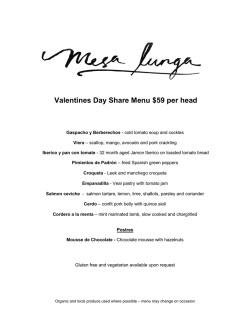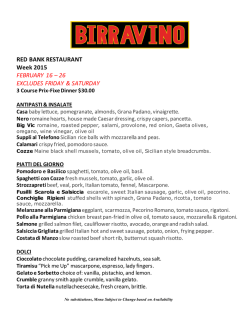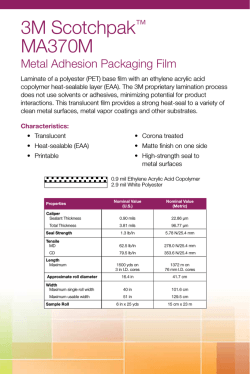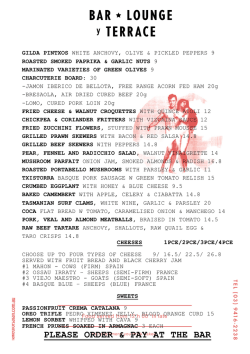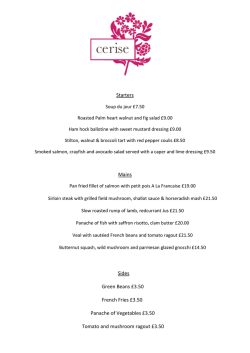
ER5, a tomato cDNA encoding an ethylene-responsive LEA
The original publication is available at www.springerlink.com ER5, a tomato cDNA encoding an ethylene-responsive LEA-like protein: characterization and expression in response to drought, ABA and wounding Hicham Zegzouti, Brian Jones, Christel Marty, Jean-Marc Leli`evre, Alain Latch´e, Jean-Claude Pech and Mondher Bouzayen Ecole Nationale Sup´erieure Agronomique de Toulouse, UA-INRA, 145, Avenue de Muret, 31076 Toulouse Cedex, France ( author for correspondence) Key words: differential display, drought stress, ethylene inducible, LEA protein, Lycopersicon esculentum, RT-PCR Abstract We report the isolation by differential display of a novel tomato ethylene-responsive cDNA, designated ER5. RT-PCR analysis of ER5 expression revealed an early (15 min) and transient induction by ethylene in tomato fruit, leaves and roots. ER5 mRNA accumulated during 2 h of ethylene treatment and thereafter underwent a dramatic decline leading to undetectable expression after 5 h of treatment. The full-length cDNA clone of 748 bp was obtained and DNA sequence analysis showed strong homologies to members of the atypical hydrophobic group of the LEA protein family. The predicted amino acid sequence shows 67%, 64%, 64%, and 61% sequence identity with the tomato Lemmi9, soybean D95-4, cotton Lea14-A, and resurrection plant pcC27-45 gene products, respectively. As with the other members of this group, ER5 encodes a predominantly hydrophobic protein. Prolonged drought stress stimulates ER5 expression in leaves and roots, while ABA induction of this ethylene-responsive clone is confined to the leaves. The use of 1-MCP, an inhibitor of ethylene action, indicates that the drought induction of ER5 is ethylene-mediated in tomato roots. Finally, wounding stimulates ER5 mRNA accumulation in leaves and roots. Among the Lea gene family this novel clone is the first to display an ethylene-regulated expression. Introduction Lea (late embryogenesis-abundant) genes encode a diverse group of putative desiccation protectant proteins that are induced during the post-abscission stage of late embryo development [15]. Lea and lea-like genes have also been isolated from vegetative tissues and are induced by water stress, as well as osmotic and low-temperature stress [6, 28]. Most members of this extensive group of genes are responsive to exogenous ABA, a phytohormone whose levels increase during water stress [7, 8]. While the majority of LEA proteins are hydrophilic, there is an atypical group of LEA proteins that contain an abundance of hydrophobic domains. The soybean D95-4 [23], cotton Lea14-A [10], tomato Lemmi9 [29] The nucleotide sequence data reported will appear in the EMBL, GenBank and DDBJ Nucleotide Sequence Databases under the accession number U77719. and resurrection plant pcC27-45 gene products [26] are among this group. All but the tomato Lemmi9 encode proteins that are induced by both drought and ABA treatment. It has been speculated that the function of these highly homologous proteins may differ from that of the hydrophilic LEA proteins [10]. In higher plants, ethylene plays a critical role in a number of physiological processes both during normal development and in response to environmental change [for review, see 30]. The identification of ethyleneregulated genes is important for understanding the role of ethylene in these processes. We recently initiated a project aimed at isolating ethylene-responsive genes in tomato fruit using a sensitive new approach, suitable for the isolation of weakly expressed genes, known as mRNA differential display [19, 20, 31]. To date, several ethylene-regulated cDNA clones have been isolated. In this paper we describe the isolation and characterization of ER5, a novel tomato ethylene-regulated cDNA. This clone encodes a protein which is highly homologous to the atypical group of LEA proteins. The expression of the ER5 gene in response to ethylene, ABA, drought and wounding are analysed and discussed. Materials and methods Plant material For the differential display experiment, Lycopersicon esculentum (cv. Evita) plants were grown in soil under standard greenhouse conditions. Late immature green fruit, unable to produce ripening-related ethylene, were harvested and treated in 10-litre sealed jars with 50 l/l of ethylene for 15 min, 30 min, 1 h, 2 h or 5 h. The control fruit were exposed to air alone. For all other experiments, tomato plants were grown hydroponically in a greenhouse (26 C day, 21 C night) in half-strength Hoagland’s solution. The whole plant ethylene treatment was as follows. Tomato plants of about 30 cm high were treated with 50 l/l of ethylene for either 1 h or 5 h while control plants were exposed to air alone. The 1-methylcyclopropene (1-MCP) [27] treatment (1 l/l for 2 h) was performed on fruit or whole plants prior to ethylene treatment. For the drought treatment, watering was stopped when the tomato plants were about 20 cm high. The drought conditions continued until the plants showed visible signs of wilting (11 days). Meanwhile, watering continued normally for control plants. For the 1-MCP treatment, the plants were treated for 2 h once a day with 1 l/l of 1-MCP throughout the period of drought stress. For the ABA experiment, tomato plants of about 30 cm high were treated with 100 M ABA (Mixed isomers, Sigma) both by spraying the aerial parts and by watering. Plants were harvested 4 h after the ABA treatment. In the wounding experiment, roots and leaves from 30 cm high tomato plants were cut into pieces and left for 3 h in air before the RNA was extracted. The 1MCP treatment (1 /l for 2 h) was performed on whole plants prior to wounding. For all treatments, harvested tissue was immediately frozen in liquid nitrogen and stored at ,80 C until RNA extraction. In all experiments RNA was extracted according to Hamilton et al. [12]. Differential display screening Total RNA was extracted from both ethylene treated and untreated late immature green tomato fruits. The differential display step was performed as previously described [19, 20, 31]. The cDNA fragment, ER5, was isolated using the primers T11GC (50 TTTTTTTTTTTGC-30) and H8 (50 -CTGATCCAGG30 ). The fragment was then cloned into the pGEM-T vector (Promega, France) according to the manufacturer’s protocol. RT-PCR analysis The RT-PCR analysis was carried out as previously described [18, 31]. After the reverse transcription step the total cDNA served as a template in the PCR amplification reaction using 2 M of ER5-specific primers (RT5n-50, 50 GATGTGCCAGTGAAGGTACCTC-30 and RT5n-30 , 50 -GTGATATGTTCGAATATGGTATCC-30). As an internal control, a fragment of the endogenous tomato ubiquitin cDNA Ubi3 [14] was amplified concomitantly with ER5 by adding 2 M of Ubi3-specific primers to the PCR reaction. The PCR products were separated on a 1.4% agarose gel, transferred to a nylon membrane and hybridized with a mixture of [32 P]dCTP-labelled ER5 and Ubi3 probes. The probes were synthesized by PCR using ER5 or Ubi3 specific primers and plasmid DNA as a template in the presence of 200 M dNTP and 10 Ci [-32 P]dCTP. The membranes were then washed according to the manufacturer’s instructions (GeneScreen Plus, Dupont) and exposed to Amersham Hyperfilm-MP at ,80 C for 30 min. TAS14 cDNA [11] was subjected to the same RT-PCR conditions as ER5. The primers used for the amplification were designed from the TAS14 sequence (GenBank accession number X51904). Isolation of the 50 end of the ER5 cDNA by 50 RACE Using the 50 RACE system (rapid amplification of 50 cDNA ends, Clontech), the 50 end of the cDNA was isolated according to the manufacturer’s instructions. Poly(A)+ RNA mixture (1 g) from ethylenetreated and untreated fruit was used as a template for the reverse transcription reaction using the anchored oligo-(dT) primer supplied with the kit. The PCR amplification was carried out using an ER5-specific primer (RT5n-30 ) and the adaptor homologous primer (50 end) supplied with the kit. PCR products were sep- arated on a 0.8% agarose gel to verify the amplification and the amplified DNA was cloned into the pGEM-T vector (Promega, France). After transformation, the recombinant colonies were screened by PCR in order to identify the longest cDNA fragment which corresponds to the full-length ER5 clone. DNA and amino acid sequence analysis The ER5 cDNA clone was sequenced from both sides with universal primers using the Thermosequenase cycle sequencing kit (Amersham) according to the supplier’s instructions. The reaction was carried out in the presence of [-35 S]dATP. The following cycling parameters were used: 50 cycles of 95 C/20 s, 60 C/30 s were applied to the labelling step and 60 cycles of 95 C/30 s, 72 C/1 min to the termination step. Database searches and comparison with published sequences were carried out using the BLAST program [2]. Genomic DNA analysis of ER5 Tomato genomic DNA was isolated from young leaves according to Hamilton et al. [12]. Ca. 10 g of DNA were digested with either EcoRI, BamHI, or doubledigested with EcoRI and BamHI. After separation on 0.8% agarose gel, the DNA was transferred to GeneScreen Plus membrane (DuPont). The hybridization with [-32 P]dCTP-labelled ER5 cDNA and the washing (2 SSC at 60 C) were performed according to the manufacturer’s recommendations. Results Isolation of an ethylene-inducible Lea- like cDNA by differential display Total RNA isolated from ethylene-treated and untreated tomato fruit was subjected to mRNA differential display analysis using a variety of primer combinations. Subsequent screening of the differential fragments [31] led to the isolation and cloning of several ethylene-responsive (ERn) cDNAs (Zegzouti et al., in preparation). Of these, ER5 was chosen for further analysis because the differential display indicated a transient expression pattern and because of its strong homology to members of the Lea gene family. The ER5 fragment recovered from the differential display gel was 487 bp long and corresponded to the 30 portion of the cDNA. Nucleotide sequence analysis of this fragment revealed significant homology to the atypical group of Lea genes. In particular, regions of the ER5 clone displayed 81% identity with the tomato nematode-induced cDNA Lemmi9 [29] and 71% with the cotton Lea14-A cDNA [10]. Northern analysis failed to detect the presence of ER5 transcripts in any of the tissues analysed. The more sensitive RT-PCR method was therefore adopted to study its expression. As an internal control for the RT-PCR, primers specific for the constitutively expressed tomato ubiquitin gene [14] were added to the PCR reaction. In this way, concomitant amplification occurred for the ubiquitin control and the ER5 cDNA. The time course of ethyleneinduced expression of ER5 in tomato fruits showed that while the level of ubiquitin transcripts remained constant throughout the experiment, ER5 transcripts were induced within 15 min and continued to accumulate until 2 h of hormone treatment (Figure 1A). Thereafter, consistent with the differential display pattern, ER5 transcript accumulation underwent a dramatic decline leading to minimal expression after 5 h treatment. Similar transient induction was observed in tomato roots and leaves treated with 50 l/l of ethylene (Figure 1B). It should be noted that ER5 transcripts were present at a basal level in tomato leaves prior to ethylene treatment. The high sensitivity of the RT-PCR technique also allowed detection of a basal level of ER5 transcripts in roots, though it was significantly lower than that in leaves. In order to control the ethylene-dependent expression of ER5, we analysed the accumulation of its transcript in tomato fruit, roots, and leaves treated with the potent inhibitor of ethylene action 1-MCP [27] for 2 h prior to ethylene treatment (Figure 1). The data presented in Figure 1 indicate that 1-MCP greatly suppressed ER5 transcript accumulation observed in ethylene-treated fruit, roots, and leaves. Deduced amino acid sequence and genomic Southern blot analysis In order to characterize this ethylene-inducible Lealike gene and polypeptide, the full-length sequence was obtained via 50 RACE and subsequently cloned. The longest clone (748 bp) gave an open reading frame corresponding to a predicted amino acid sequence of 160 residues (Figure 2A). To determine whether, in tomato, ER5 is a member of a gene family, genomic DNA was isolated from young leaves and digested with restriction enzymes EcoRI, BamHI, or double-digested with Figure 1. Rapid and transient accumulation of ER5 mRNA after treatment with ethylene. A. Time course of ER5 ethylene induction in tomato fruit. Total RNA from late immature green tomato fruit untreated (0) or treated with 50 l/l ethylene for 15 min, 30 min, 1 h, 2 h, or 5 h were reverse transcribed in the presence of an oligo-d(T)21 primer. The PCR amplifications were performed using ER5 cDNA specific primers. As an internal control, the endogenous tomato ubiquitin cDNA (Ubi3) [14] was amplified concomitantly with ER5 by adding Ubi3-specific primers to the PCR reaction. The PCR products were separated on a 1.4% agarose gel, transferred to a nylon membrane and hybridized with a mixture of [ -32 ]dCTPlabelled ER5 and Ubi3 probes. The membranes were exposed to Amersham Hyperfilm-MP at 80 C for 30 min. B. Ethyleneregulated expression of ER5 in tomato leaves and roots. RT-PCR analysis was performed as described above using total RNA from tomato leaves and roots untreated (0) or treated with 50 l/l ethylene for 1 h or 5 h. The ethylene-dependent expression of ER5 was controlled by analysing the accumulation of ER5 transcript in tomato fruit, roots, and leaves treated with 1-MCP for 2 h prior to ethylene treatment (1h MCP). , + EcoRI and BamHI. The DNA gel blot was probed with the radiolabelled full-length ER5 cDNA. The results of the Southern analysis (Figure 2B) showed that under mild stringency washing conditions, both EcoRI and BamHI digests generated one major band that strongly hybridized to the ER5 probe and at least two weaker bands. Under high-stringency washing (0 :2 SSC, 60 C) only the single major band was detected (data not shown). The ER5 gene product showed substantial amino acid homology to members of the atypical hydrophobic group of LEA proteins, having 67%, 64%, 64%, and 61% amino acid identity with the predicted tomato Lemmi9 [29], soybean D95-4 [23], cotton Lea14A [10], and resurrection plant pcC27-45 [26] gene products, respectively (Figure 3A). The ER5 protein is highly hydrophobic and its hydropathy plot, shown in Figure 3B, is very similar to that of the atypical LEA proteins cited above (data not shown). Figure 2. A. Nucleotide and deduced amino acid sequences of ER5. The amino acid sequence of the ER5 protein is noted in oneletter code below the nucleotide sequence. The start and stop codons and the putative polyadenylation signal are denoted in bold face. H8 is the arbitrary primer used in the differential display PCR. The sequence of the forward primer RT5n-50 and the complemetary sequence of the reverse primer RT5n-30 used in RT-PCR analysis are shown. RT5n-30 was also used for the 50 RACE to amplify the full length ER5 cDNA. B. Genomic Southern blot analysis of the ER5 gene. Tomato genomic DNA (10 g/lane) was digested with EcoRI (E), BamHI (B), and EcoRI BamHI (B/E). The DNA was separated on an 0.8% agarose gel, transferred onto a nylon membrane (GeneScreen, DuPont) and probed with ER5 cDNA probe. The washing was performed under mild-stringency conditions (2 SSC, 0.1% SDS, 60 C). Size markers (kb) are indicated to the right. + Figure 3. A. Comparison of the deduced amino acid sequence of ER5 (L. esculentum) with those of Lemmi9 (L. esculentum) [29], Lea14-A (G. hirsutum) [10], D95-4 (G. max) [23] and pcC27-45 (C. plantagineum) [26] (GenBank U77719, Z46654, M88322, U08108, M62990, respectively). Dashes show gaps introduced to optimise the alignment. Amino acid numbers beside the sequences exclude gaps. Black boxes show amino acid homology between ER5 and the LEA-like proteins. B. Hydropathic index analysis of the ER5 deduced amino acid sequence. Hydrophobic domains are above the dotted line and the hydrophilic domains below it. The analysis was performed according to Kyte and Doolittle [17]. Effects of drought stress on ER5 transcript levels To further understand the regulation of this Lea-like gene, we analysed its expression in response to drought stress. RT-PCR studies showed that after 11 days of dehydration, ER5 mRNA levels increased in both tomato leaves and roots (Figure 4A). Since ER5 was initially isolated as an ethylene-responsive gene, and ethylene production is known to be induced by water deficit [1], we investigated the role of ethylene in the drought induction of this gene. A potent inhibitor of ethylene action, 1-MCP [27], applied throughout the Figure 4. RT-PCR analysis of ER5 and TAS14 expression in response to drought stress. ER5 (A) and TAS14 (B) mRNA accumulation was analysed by RT-PCR as described in Figure 1, using total RNA from drought-stressed (D), continuously watered (C) and droughted 1-MCP-treated (D MCP) tomato roots and leaves. For the ethylene action inhibition experiment, plants were treated with 1 l/l 1-MCP for 2 h once a day throughout the drought stress. + 11 days of drought stress greatly suppressed droughtinduced ER5 transcript accumulation in roots but not in leaves (Figure 4A). The effectiveness of the drought treatment in roots and leaves (Figure 4B) was shown by analysing the expression of TAS14, a drought and ABA inducible tomato gene [11]. Expression of the ER5 gene in response to ABA treatment ER5 transcript accumulation in response to exogenous ABA was examined in tomato roots and leaves. Figure 5A indicates that the ER5 mRNA level increased significantly in tomato leaves within 4 h of ABA treatment (100 M). In contrast, no induction of the ER5 gene was observed in tomato roots. As with the drought treatment, the effectiveness of the ABA treatment was validated by analysing the accumulation of TAS14 mRNA (Figure 5B). Influence of wounding on the expression of ER5 We also analysed the effect of mechanical wounding on ER5 transcript accumulation in tomato roots and leaves. As shown in Figure 6, ER5 transcripts accumulate within 3 hours of wounding in tomato roots and leaves. To test whether ethylene is involved in the wound-induced expression of the ER5 gene we analysed its expression in tomato plants treated with 1 l/l of 1-MCP prior to wounding. Figure 6 shows that 1MCP was ineffective in preventing the wound-induced accumulation of ER5 mRNA, suggesting that ethylene Figure 5. RT-PCR analysis of ER5 and TAS14 expression in response to 100 M ABA treatment. ER5 (A) and TAS14 (B) mRNA accumulation was analysed by RT-PCR as previously described (Figure 1), using total RNA from tomato roots and leaves either untreated (C) or treated with ABA for 4 h (ABA). Figure 6. RT-PCR analysis of the wound-induced expression of ER5. Total RNA from, unwounded (C) wounded (W) and 1-MCPtreated (W MCP) wounded tomato roots and leaves were subjected to RT-PCR analysis using ER5 specific primers (see Figure 1). For the ethylene action inhibition experiment, plants were treated with 1-MCP [27] 2 h prior to wounding. + alone cannot account for the wound-induced expression of ER5. Discussion The identification of ethylene-regulated genes is an important strategy in defining the role of ethylene in various physiological processes in higher plants. We have used mRNA differential display to identify ethylene-regulated genes in tomato. In this paper we describe the isolation and characterization of ER5, a novel ethylene-responsive tomato cDNA. In late immature green fruit, ER5 is rapidly and transiently induced upon ethylene treatment with a similar expression pattern occurring in tomato leaves and roots. Sequence homology studies indicated that the ER5 cDNA encodes a new member of the atypical hydrophobic LEA protein group represented by the cotton Lea14-A, soybean D95-4, resurrection plant pcC27-45, and tomato Lemmi9. The ER5 predicted protein also displays a majority of hydrophobic domains similar to those found in the other members of this group. In recent years many ethylene-induced genes have been isolated and their expression patterns characterized [5, 21]. ER5 is the first Lea-like gene reported to be ethylene-induced. Southern blot experiments revealed one major band and at least two weaker bands. This indicates that the tomato genome contains a few genes that are distantly related to ER5 and the tomato Lemmi9 gene may be one of these. Our data show that, as with many Lea genes [16], ER5 is induced by drought stress in both roots and leaves. Moreover, in tomato roots this drought induction appears to be mediated by ethylene since the inhibitor of ethylene action, 1-MCP, efficiently prevents its expression during drought stress. In contrast, 1-MCP failed to eliminate the drought-induced expression of ER5 in tomato leaves indicating the existence of at least two different drought response pathways. The efficiency of 1-MCP treatment in suppressing the ethylene-induced ER5 transcript accumulation is shown in Figure 1. Although it is well known that ethylene production increases in response to water deficit [1, 3, 9], its role in the response mechanism is not established. Here we demonstrate for the first time that drought-induced gene expression can be mediated by ethylene. However, the expression pattern obtained during drought might differ from the transient induction observed upon exogenous ethylene treatment. Our results also show that the drought related expression of ethylene-responsive genes may involve other factors beside ethylene. Since exogenous ABA induced ER5 expression in leaves, it is possible that this hormone, whose levels increase during water stress [7], is involved in the drought induction of the ER5 gene in leaf tissues. In this paper, we show that ethylene alone cannot account for the wound-induced expression of this ethylene-responsive Lea-like gene since the accumulation of ER5 transcript in response to wounding cannot be suppressed by 1-MCP. While an increase in ethylene biosynthesis has been associated with the initial response to mechanical wounding [4, 22] it has also been shown that in tomato only 15% of the proteins which accumulate upon wounding are directly related to an ethylene response pathway [13]. Evidence exists for the involvement of ABA in the wound response [24, 25] and the induction of ER5 by ABA in leaves (Figure 5) may suggest this phytohormone is involved in the wound-regulated expression of this gene. The function of the ER5 protein, as well as the mechanism by which this gene is regulated during various stress conditions remain to be elucidated. The early and transient induction of the ER5 gene by ethylene may, however, suggest a regulatory role for its encoded protein. Moreover, based on the dominant hydrophobic character of the predicted polypeptide it is likely that ER5 and other related LEA-like proteins play a different role to the large group of hydrophilic LEA proteins. In conclusion our results indicate that, beside ABA, ethylene participates in gene induction during drought stress. Furthermore, the ethylene responsiveness of this tomato Lea-like gene raises the possibility that this hormone may be involved in the regulation of other Lea genes. Deletion analysis of the ER5 gene promoter may reveal differentially activated cis elements necessary to explain the complex pattern of expression shown in this study. Acknowledgements This work was supported by the E.U. (FAIR, CT95– 0225) and the Midi-Pyr´en´ees Regional Council. B. Jones received a ‘RIRDC’ scholarship. The authors are grateful to Drs T. Bouquin and P. Guillen for stimulating discussions. References 1. 2. 3. 4. 5. 6. 7. 8. 9. Abeles FB, Morgan PW, Salveit ME: Ethylene in Plant Biology, 2nd ed. Academic Press, San Diego, CA (1992). Altschul SF, Gish W, Miller W, Myers EW, Lipman DJ: Basic local alignment search tool. J Mol Biol 215: 403–410 (1990). Apelbaum A, Yang SF: Biosynthesis of stress ethylene induced by water deficit. Plant Physiol 68: 594–596 (1981). Boller T, Kende H: Regulation of wound ethylene synthesis in plants. Nature 286: 259–260 (1980). Broglie KE, Gaynor JJ, Broglie RM: Ethylene-regulated gene expression: molecular cloning of the genes encoding an endochitinase from Phaseolus vulgaris. Proc Natl Acad Sci USA 83: 6820–6824 (1986). Bray EA: Molecular response to water deficit. Plant Physiol 103: 1035–1040 (1993). Chandler PM, Robertson M: Gene expression regulated by abscisic acid and its relation to stress tolerance. Annu Rev Plant Physiol Plant Mol Biol 45: 113–141 (1994). Dure L III: The LEA proteins of higher plants. In: Verma DPS (ed) Control of Plant Gene Expression, pp. 325–335. CRC Press, Boca Raton, FL (1993). Fluhr R, Mattoo AK: Ethylene- Biosynthesis and perception. Crit Rev Plant Sci 15: 479–523 (1996). 10. Galau GA, Wang HY-C, Hughes DW: Cotton Lea5 and Lea14 encode atypical late embryogenesis-abundant proteins. Plant Physiol 101: 695–696 (1993). 11. Godoy GA, Pardo LM, Pintor-Toro JA: A tomato cDNA inducible by salt stress and abscisic acid: nucleotide sequence and expression pattern. Plant Mol Biol 15: 695–705 (1990). 12. Hamilton AJ, Lycett GW, Grierson D: Antisense gene that inhibits synthesis of the hormone ethylene in transgenic plants. Nature 346: 284–287 (1990). 13. Henstrand JM, Handa AK: Effect of ethylene action inhibitors upon wound-induced gene expression in tomato pericarp. Plant Physiol 91: 157–162 (1989). 14. Hoffman NE, Ko K, Milkowski D, Pichersky E: Isolation and characterization of tomato cDNA and genomic clones encoding the ubiquitin gene ubi3. Plant Mol Biol 17: 1189–1201 (1991). 15. Hughes DW, Galau GA: Developmental and environmental induction of Lea and LeaA mRNAs and the postabscission program during embryo culture. Plant Cell 3: 605–618 (1991). 16. Ingram J, Bartels D: The molecular basis of dehydration tolerance in plants. Annu Rev Plant Physiol Plant Mol Biol 47: 377–403 (1996). 17. Kyte J, Doolittle RF: A simple method for displaying the hydropathic character of a protein. J Mol Biol 157: 105–132 (1982). 18. Lasserre E, Bouquin T, Hernandez JA, Bull J, Pech J-C, Balague C: Structure and expression of three genes encoding ACC oxidase homologs from melon (Cucumis melo L.). Mol Gen Genet 251: 81–90 (1996). 19. Liang P, Pardee AB: Differential display of eukaryotic messenger RNA by means of the polymerase chain reaction. Science 257: 967–971 (1992). 20. Liang P, Averboukh L, Pardee AB: Distribution and cloning of eukaryotic mRNAs by means of differential display: refinements and optimization. Nucl Acids Res 21: 3269–3275 (1993). 21. Lincoln JE, Cordes S, Read E, Fisher RL: Regulation of gene expression by ethylene during Lycopersicon esculentum (tomato) fruit development. Proc Natl Acad Sci, USA 84: 2793–2797 (1987). 22. Lincoln JE, Campbell AD, Oetiker J, Rottman WH, Oeller PW, Shen NF, Theologis A: LE-ACS4: a fruit ripening and 23. 24. 25. 26. 27. 28. 29. 30. 31. wound-induced 1-aminocyclopropane-1-carboxylate synthase gene of tomato (Lycopersicon esculentum). J Biol Chem 268: 19422–19430 (1993). Maitra N, Cushman JC: Isolation and characterization of drought-induced soybean cDNA encoding a D95 family late embryogenesis-abundant protein. Plant Physiol 106: 805–806 (1994). Pena-Cort´es H, Sanchez-Serano JJ, Mertens R, Willmitzer L, Prat S: Abscisic acid is involved in the wound-induced expression of the proteinase inhibitor II gene in potato and tomato. Proc Natl Acad Sci USA 86: 9851–9855 (1989). Pena-Cort´es H, Willmitzer L: The role of hormones in gene activation in response to wounding. In: Davies PJ (ed) Plant Hormones: Physiology, Biochemistry, and Molecular Biology, pp. 395–414. Kluwer Academic Publishers, Dordrecht, Netherlands (1995). Piatkowski D, Schneider K, Salamini F, Bartels D: Characterization of five abscisic acid-responsive cDNA clones isolated from dessication-tolerant plant Craterostigma plantagineum and their relationship to other water-stress genes. Plant Physiol 94: 1682–1688 (1990). Sisler EC, Serek M, Dupille E: Comparison of cyclopropene, 1methylcyclopropene, and 3,3-dimethylcyclopropene as ethylene antagonists in plants. Plant Growth Regul 17: 1–6 (1995). Skriver K, Mundy J: Gene expression in response to abscisic acid and osmotic stress. Plant Cell 2: 503–512 (1991). Van der eycken W, de Almeida Engler J, Inze D, Van Montagu M, Gheysen G: A molecular study of root-knot nematode-induced feeding sites. Plant J 9: 45–54 (1996). Zarembinski TI, Theologis A: Ethylene biosynthesis and action: a case of conservation. Plant Mol Biol 26: 1579–1597 (1994). Zegzouti H, Marty C, Jones B, Bouqin T, Latch´e A, Pech J-C, Bouzayen M: Improved screening of cDNAs generated by mRNA differential display enables the selection of true positives and the isolation of weakly expressed messages. Plant Mol Biol Reporter 15(3): 236–245 (1997)
© Copyright 2025
